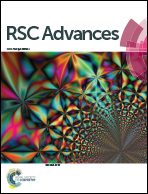Electropolymerization using binuclear nickel(ii) Schiff base complexes bearing N4O4 donors as supramolecular building blocks†
Abstract
The supramolecular building blocks from a nickel(II) bisalphen-type complex have been reported. The conjugations through the bridge provide flexibility of the monomer in the electropolymerization stage. Thus, different structures can be obtained with the variation of electrochemical parameters used in the electropolymerization. The structural characterization and the electrochemical behavior in aqueous solution was also evaluated, which demonstrated that the electropolymerization mechanism was similar to that observed for the classical salen polymers, but the molecular organization onto the conductor substrate was different. The supramolecular structure of the polymeric film allows observation of the NiI/NiII and NiII/NiIII redox couples by differential pulse voltammetry. Thus, the comproportionation constant and Gibbs energy were calculated for the NiI/NiII redox couple. These characteristics make these polymers versatile materials in the field of supramolecular chemistry and materials science, in particular in applications as sensors, in electrocatalysts and for energy storage.



 Please wait while we load your content...
Please wait while we load your content...